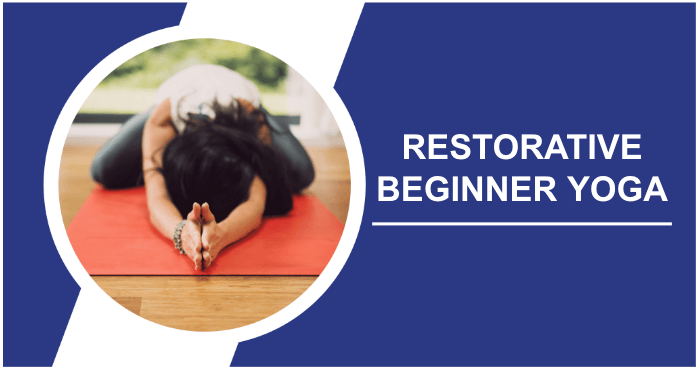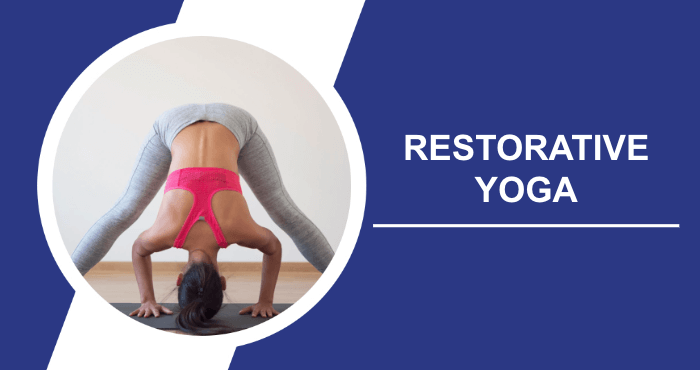Have you ever wanted an alternative to diets and long hours at the gym? Can yoga help you lose weight? In restorative yoga, various asanas (postures) are performed for a set period of time with the support of props.
In fact, the practice of yoga not only helps to lose weight and achieve a better physique. It is also the most effective way to reduce stress. It calms your body and mind, leaving you feeling more balanced and less stressed. In this article, you will learn more about restorative yoga for weight loss and the benefits of yoga practice.
Is Restorative Yoga Beneficial?
Yes, it is. Here are some of the benefits of yoga for weight loss that you may not be aware of:
- Improved well-being
- Improved sleep patterns
- Relief from chronic pain
- A more relaxed nervous system
- Reduced stress
How Often Should I Practice Restorative Yoga?
Ideally, Restorative Yoga can be practised every day, especially if you’re looking for deep relaxation and stress relief. However, for those with a busy schedule, 1-2 times a week can still provide significant benefits and maintain flexibility. Listen to your body’s needs and adjust accordingly.
How Can Restorative Yoga Help With Weight Loss?
In fact, a prolonged yoga pose combined with deeper breathing is essential in restorative yoga for shedding pounds. This creates a relaxation response that is remarkably beneficial for your body. It lowers blood pressure and soothes your muscles, releasing tension.
The primary benefit of restorative yoga is its effect on your physique, which encourages behavioural change. Every part of the body, including the torso, legs and even the mind, experiences relaxation. Essentially, your body experiences less stress, which is crucial for weight loss. Some of the health benefits your body and weight loss goals will reap include:
1. Improve Well-Being
Along with good health, one of the most important elements for your body is well-being. Studies show that practising yoga has a number of therapeutic benefits that can help you feel better. It’s also much easier to burn calories and lose weight when your body is happy.
So adopt restorative yoga and gain greater mindfulness. With each pose, you inhale deeper, achieve a healthy weight, and take a broader view of your life and the cosmos. This also means that you experience less fatigue-related body aches and pains, and you can enjoy each day with more vitality.
2. Improved Sleep Cycles
Did you know that poor sleep can sabotage your weight loss efforts? Without adequate rest, your body cannot relax properly. However, getting more sleep can be a challenge when you are tense and stressed. This is where the practice of restorative yoga comes in. The various asanas performed help to calm both your body and mind. Research suggests that restorative yoga can promote improved sleep patterns by inducing neuroendocrine changes and lowering cortisol levels.
3. Relieves Chronic Pain
Each asana in restorative yoga uses supports and involves stretching. Stretching is essential if you suffer from chronic pain and want to release body tension. Your body becomes less sensitive to pain. This is particularly important for women’s wellbeing, according to a study of older women. Consistent yoga practice reduces pain levels. The effect of each posture is enhanced by deeper breathing and increased focus. To learn more about chronic pain relief, daily asana practice promotes relaxation.
4. Calming The Nervous System
When stress and anxiety dominate, your body stiffens and becomes a source of discomfort. Recognising this, it’s important to look for relaxation methods that help your nervous system. Moving from a fight-or-flight state to a calm demeanour, this form of yoga nourishes the body from the inside out and has a positive effect on the nervous system. The varied asanas of restorative yoga help to balance the body, which benefits the nervous system.
5. Reduces Stress
Left unchecked, stress can take over your mind and body. Fortunately, restorative yoga has proven to be a successful remedy over time. People have used these poses to relax and relieve stress. It’s a time-honoured and effective technique. It’s even more beneficial for reducing anxiety, especially if you suffer from a chronic illness. Eliminating stress improves the likelihood that treatments will restore your body to optimal health. Once you have understood its many benefits, you may wish to try a few asanas to get started.
Is Restorative Yoga Suitable For Beginners?

Restorative yoga is ideal for beginners. It focuses on relaxation and gentle stretching, using props such as blankets and bolsters to support the body. This style emphasises holding poses for longer periods of time, promoting deep relaxation and stress reduction. Its gentle nature makes it ideal for those new to yoga, those with limited mobility or those seeking a soothing practice. It’s the perfect starting point for anyone looking to explore yoga in a non-intimidating, calming way.
3 Rejuvenating Yoga Poses To Lose Weight
If you are looking for professional guidance on rejuvenating yoga, start with the three poses highlighted in this article. They are easy to perform. You can expand and refine them as your expertise grows.
1. Child’s Pose
Begin with this pose if you want to eliminate subcutaneous fat from your body. It’s easy because you start by sitting on your heels. Make sure you have a good quality yoga mat. Keep your knees apart and lean forward. As you bend your torso, allow your belly to rest on the area between your thighs. Next, place your forehead on the mat and stretch your arms forward. Maintain this downward facing position as you inhale and exhale.
With further exploration, you’ll discover that there are many different child poses possible. For a more therapeutic yoga experience, consider placing a bolster between your legs.
2. Supine Bound Angle Pose
For overweight women who want to lose weight, gentle yoga is a beneficial approach. The poses are simple, such as the supine bound angle pose. Begin by lying on your back, with your knees bent and your pelvis close together. Bring your knees as close together as possible, then spread them out to the sides of your body. Connect the soles of your feet and place supports under each knee for stability.
Remember that these exercises are meant to be soothing, so use props for support. Rest there for a while while you relax and breathe in with minimal strain on your body. Breathe in gently for five minutes as this will also strengthen your core muscles.
3. Supported Forward Bend
The third pose to try is the supported forward bend. Begin by sitting on a mat on the floor, then roll out an additional yoga mat to rest on your legs. Make sure the mat is resting on your straight legs before continuing. Bend your torso forward until your forehead touches the mat on your thighs. You can deepen the bend and briefly rest your face on the mat. Let your arms rest next to your legs. Calm and regular breathing is also important in this pose.
These three yoga poses can greatly improve your overall health and well-being, as well as reduce cortisol levels in your system, which is particularly beneficial for overweight women. Staying calm and reducing stress is key when focusing on fat loss. Not to mention feeling less anxious and maintaining a more positive mood.
How Much Does A Restorative Yoga Class Cost?
The cost of a restorative yoga class can vary greatly depending on location, the experience level of the teacher and the setting (e.g. local studio vs. luxury retreat). Typically, a single class can cost between $15 and $25 in urban areas, and slightly less in smaller towns. Packages or membership plans can reduce the cost per class. Some studios also offer sliding scale fees or community classes at a reduced rate to make it more accessible. Prices may be higher for special workshops or classes taught by renowned instructors.
What Is Restorative Yoga?
Restorative yoga is perfect for those looking to lose weight and reduce stress. This practice involves holding a posture for several minutes, which requires stretching of the body. It burns calories, although at a slower rate than other forms of exercise. Restorative yoga is accessible and beneficial for everyone. It essentially consists of calming sun salutations performed in a relaxed manner. Each pose brings relaxation with minimal effort during a session.
These postures, called asanas, have many benefits. Sun salutations are a series of asanas designed to rejuvenate the body and mind. To get started with restorative yoga, find a qualified yoga instructor. The practice of restorative yoga requires the use of a yoga mat, blankets and various tools. Proper yoga practice helps with weight management and promotes relaxation.
Calories are burned during asana practice. Restorative yoga also includes meditative yoga. Meditation involves visualising your ideal body weight and focusing on this image while regulating your breathing. In restorative yoga, props are often used to support your body, allowing you to hold each posture effortlessly. As your body begins to relax and unwind, you’ll notice a reduction in physical tension and mental clarity. Your task is to perform the yoga postures and control your breath. In addition, be aware of the thoughts that arise during your meditation.
What Equipment Do I Need For Restorative Yoga?
For restorative yoga, you’ll need a yoga mat for comfort and support. Bolsters provide essential support for poses, while yoga blocks help with alignment and stability. Yoga straps help with reaching and holding poses, especially for flexibility challenges. A blanket provides additional cushioning and warmth during relaxation. Eye cushions are optional but can enhance relaxation by blocking out light. Taken together, this equipment creates a supportive, comfortable environment, essential for the restorative aspect of this yoga practice.
Frequently Asked Questions
What are some of the best restorative yoga poses?
There are several yoga poses that help improve body composition and promote relaxation. Notable ones include downward dog, boat pose, cobra pose, child pose, reclined bound angle pose and supported forward fold. These poses are beneficial and require deep breathing during transitions.
Why is restorative yoga beneficial?
Restorative yoga is particularly effective for the wellbeing of the body and mind. Practicing yoga poses helps prevent weight gain and increases mental clarity. Fortunately, many yoga teachers offer excellent classes.
Can restorative yoga be practised daily?
This style of yoga is particularly calming and uses props to reduce the intensity. As a result, your body experiences minimal stress. This means that daily restorative yoga practice is feasible, as it is an optimal yoga style for weight management. In addition, consistent yoga practice significantly improves mindfulness.
How Long are Typical Restorative Yoga Sessions?
Sessions usually last between 45 minutes to an hour, allowing ample time for relaxation and meditation in each pose.
Is Restorative Yoga Safe for Everyone?
It is generally safe for most people. However, if you have specific health concerns or injuries, it’s best to consult a healthcare provider or a qualified yoga instructor.
Conclusion
How does yoga help with weight loss? Participating in this form of yoga has far-reaching benefits for both your physical and mental health. Achieving your weight goals is easy with each pose, reducing stress levels. This style of yoga uses tools to ensure that the exercises are not overly strenuous. As well as reducing belly fat, this therapeutic approach to yoga provides significant benefits to your nervous system. It also enhances overall well-being and helps to alleviate chronic conditions.
For beginners, a good place to start is with the trio of basic asana poses outlined in this article. Not only will they help you relax, but they will also help you burn calories during your practice. These poses also have a positive effect on your digestive health, maintaining your wellbeing for longer.
Sources
- Nedeltcheva, A.V., Kilkus, J.M., Imperial, J., Schoeller, D.A., and Penev, P.D. (2010). “Insufficient sleep undermines dietary efforts to reduce adiposity.” Annals of Internal Medicine, 153(7), pp.435–41. Read Article.
- Corey, S.M., Epel, E., Schembri, M., Pawlowsky, S.B., Cole, R.J., Araneta, M.R.G., Barrett-Connor, E., and Kanaya, A.M. (2014). “Effect of restorative yoga vs. stretching on diurnal cortisol dynamics and psychosocial outcomes in individuals with the metabolic syndrome: The PRYSMS randomized controlled trial.” Psychoneuroendocrinology, 49, pp.260–271. Read Article.
- Corey, S.M., et al. (2014). “Effect of restorative yoga vs. stretching on diurnal cortisol dynamics…” Psychoneuroendocrinology, 49, pp.260–271. Read Article.
- Schmid, A.A., Fruhauf, C.A., Sharp, J.L., Van Puymbroeck, M., Bair, M.J., and Portz, J.D. (2019). “Yoga for People With Chronic Pain in a Community-Based Setting: A Feasibility and Pilot RCT.” Journal of Evidence-Based Integrative Medicine, 24, p.2515690X1986376. Read Article.
- Seguin-Fowler, R., Graham, M., Ward, J., Eldridge, G., Sriram, U., and Fine, D. (2020). “Feasibility of a yoga intervention to decrease pain in older women: a randomized controlled pilot study.” BMC Geriatrics, 20(1). Read Article.
- Woodyard, C. (2011). “Exploring the therapeutic effects of yoga and its ability to increase quality of life.” International Journal of Yoga, 4(2), p.49. Read Article.
- Zetzl, T., Renner, A., Pittig, A., Jentschke, E., Roch, C., and van Oorschot, B. (2020). “Yoga effectively reduces fatigue and symptoms of depression in patients with different types of cancer.” Supportive Care in Cancer, 29(6), pp.2973–2982. Read Article.
- Raghavendra, R.M., Vadiraja, H.S., Nagarathna, R., Nagendra, H.R., Rekha, M., Vanitha, N., Gopinath, K.S., Srinath, B.S., Vishweshwara, M.S., Madhavi, Y.S., Ajaikumar, B.S., Ramesh, B.S., Nalini, R., and Kumar, V. (2009). “Effects of a Yoga Program on Cortisol Rhythm and Mood States in Early Breast Cancer Patients Undergoing Adjuvant Radiotherapy: A Randomized Controlled Trial.” Integrative Cancer Therapies, 8(1), pp.37–46. Read Article.
- Katuri, K., Dasari, A., Kurapati, S., Vinnakota, N., Bollepalli, A., and Dhulipalla, R. (2016). “Association of yoga practice and serum cortisol levels in chronic periodontitis patients with stress-related anxiety and depression.” Journal of International Society of Preventive and Community Dentistry, 6(1), p.7. Read Article.
Jayson Peterson is an experienced pharmacist, naturopathic physician, medical examiner, and minister. After earning his Doctor of Pharmacy degree from the Medical University of South Carolina, Jayson Peterson completed clinical rotations at several prestigious healthcare institutions and has been affiliated with several pharmacy chains throughout his career. His main passion and zeal is focused on providing world-class patient care by giving precise details and thorough instructions to those who need it most.

